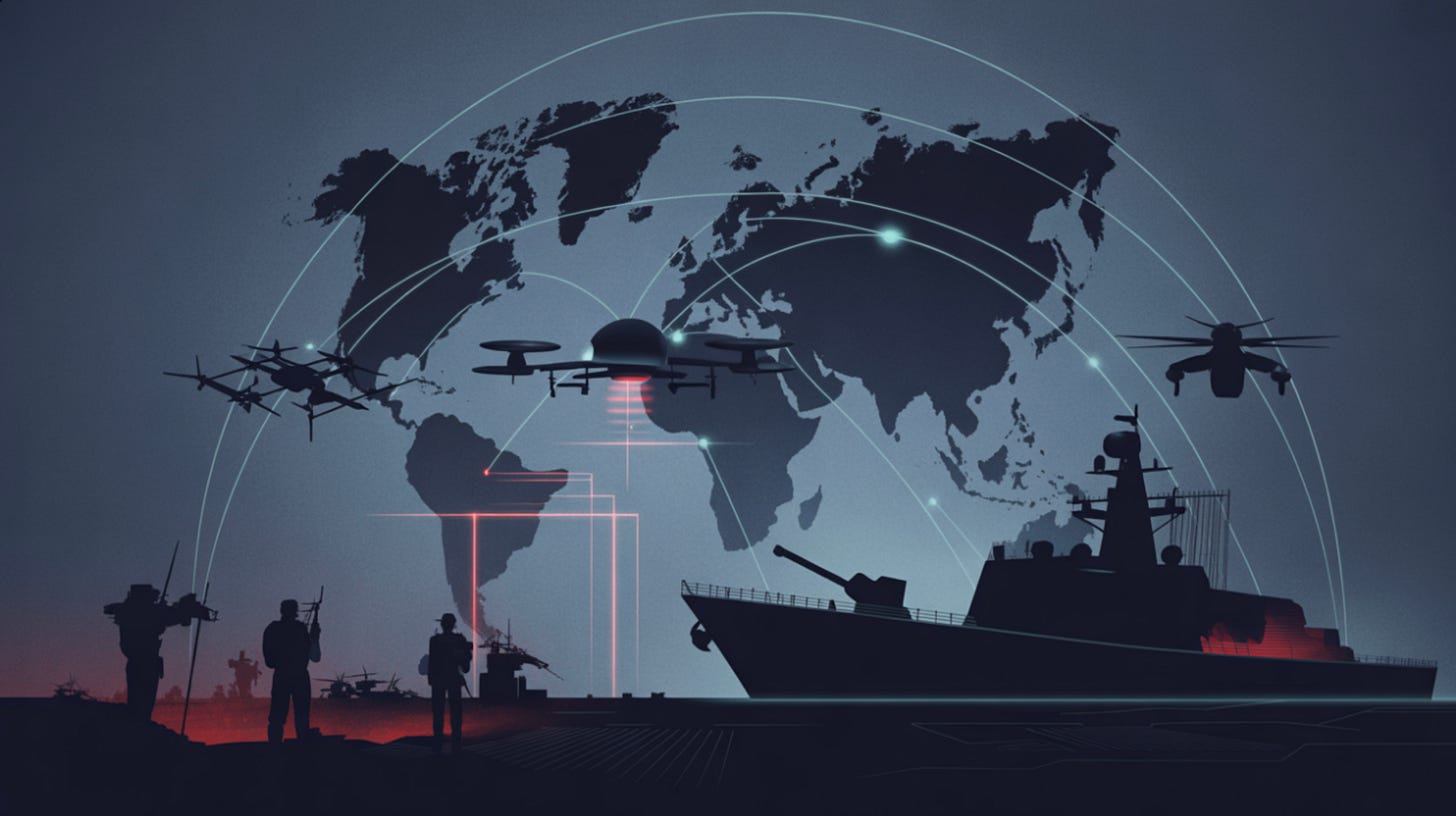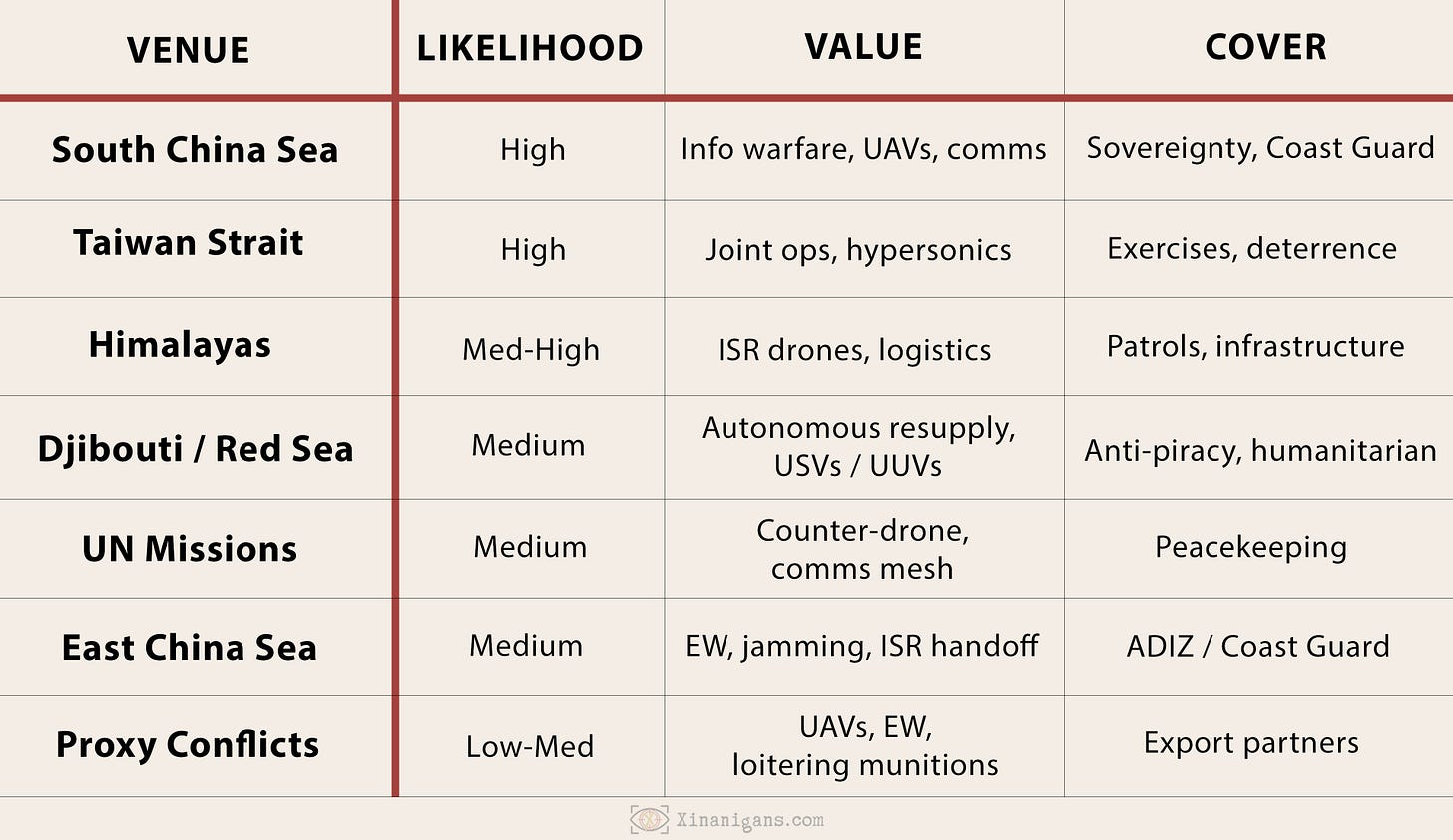China’s Military Testing Grounds: 8 Places the PLA Could Trial New Tech
From the South China Sea to outer space, Beijing is seeking safe venues to validate its next-generation military systems.

Over the past two years, military observers and policymakers have wrestled with a central question: where, and under what circumstances, will China first test its newest military technologies in the real world?
This is more than mere academic curiosity. Real-world validation is the dividing line between military theory and actual combat effectiveness, a divide that proved costly for the US when it overestimated Russia’s untested systems in Ukraine. Beijing is learning from those mistakes.
China’s leadership has promised to fully modernize the People’s Liberation Army by 2035 and build a “world-class military” by mid-century. At the same time, Party doctrine demands war control (控制战争), i.e., maintaining tight reins, avoiding miscalculation, and ensuring actions stay reversible or deniable. This forms a strategic puzzle: where can the PLA safely experiment without risking uncontrollable escalation?
This analysis maps the most probable testing venues from the South China Sea to outer space using PLA doctrine as a guide. It then sketches what a “campaign of testing” means when strategic considerations shape every move. Put simply: understanding China’s testing grounds is understanding its pathway to future warfare.
Methodology
Three filters, drawn from Chinese military doctrine and strategy, shaped the identification of test locations:
Doctrine of War Control (控制战争): The PLA demands firm political control over escalation. Any test site must allow Beijing to halt or plausibly deny activities if tensions rise.
Safety Boundaries: Rooted in unrestricted warfare thinking, China prefers arenas where tests are reversible, deniable, or produce non-lethal effects.
Strategic Payoff vs. Political Risk: Beijing aims for visible modernization advances without provoking coalition backlash.
Each location was then evaluated for: Likelihood (routine PLA presence, escalation control); Value (opportunity to validate new tech); and Cover (plausible justification for operations).
(Analyst note: These filters mirror concepts laid out in authoritative PLA texts such as the 2020 Science of Military Strategy, the classic Unrestricted Warfare, and Xi Jinping’s Party Congress reports.)
The following table summarizes how each venue scores across these criteria.
Summary Table: PLA Testing Venues
The 8 Most Likely Test Venues
1. South China Sea ➤ The Gray-Zone Laboratory
Why here: PLA maintains continuous, normalized presence in disputed waters and claims sovereignty under international law, providing legal justification and flexibility for escalation control.
Technologies to validate: UAV swarms, non-lethal dazzlers and jammers, AI-assisted maritime domain awareness, next-generation underwater data transmission for command and control, space-based targeting cues.
Likely circumstances: “Coast guard” enforcement actions, harassment of foreign survey vessels, safety-of-navigation and communication exercises in deep water and shallow zones.
Observable Activity: In August 2024, the PLA set a new record for submarine communications by testing Huawei’s polar code technology in the South China Sea, demonstrating advances in deep-sea command and control platforms relevant for contested maritime operations.
2. Taiwan Strait Air-Sea Encirclement Drills ➤ High Tempo, High Payoff
Why here: Frequent, large-scale drills normalized as “deterrence operations” provide cover for PLA experimentation. The PLA's “Cabbage Strategy” uses layered encirclement of Taiwan and foreign forces, demonstrating sophisticated cross-service coordination. The scale of recent drills indicates routine, rapid upgrades across services.
Technologies to validate: Joint command-and-control networks (cross-theater), hypersonic targeting integration, automated logistics and sustainment, standoff-range anti-ship missiles, distributed maritime-aviation operations.
Likely circumstances: Large-scale joint exercises (over 100 aircraft sorties, dozens of naval vessels), Bashi Channel and Taiwan encirclement, carrier group maneuvers, multi-layer maritime patrol and blockade simulations.
Observable Activity: On April 1–2, 2025, the PLA conducted the “Strait Thunder-2025A” drill, involving 135 aircraft, 38 naval vessels, and 12 official vessels, focused on multi-service integration, chokepoint control, and simulated encirclement of Taiwan using updated joint maneuvers and live-fire drills.
3. Himalayan Frontier (LAC with India) ➤ Extreme Environment Testbed
Why here: The high-altitude border is a technical pressure cooker where climate and terrain stress communications, drones, and logistics alike. Both China and India employ cautious escalation and avoid wide-scale conflict, allowing for controlled technology trials.
Technologies to validate: High-altitude/ISR drones, navigation in GNSS-degraded environments, autonomous and unmanned resupply, tactical communications mesh networks.
Likely circumstances: Patrol standoffs, winter rotations, infrastructure “notifications,” search-and-rescue, logistics drop simulations.
Observable Activity: In late 2023, both open-source reporting and official Indian statements confirmed large-scale PLA drone deployments for high-altitude surveillance and logistics testing along the contested LAC, including new quadcopters and high-endurance UAVs under real operational conditions.
4. Djibouti & Red Sea Littorals ➤ Overseas Base Operations
Why here: PLA’s overseas base and legitimate anti-piracy missions offer strong cover for testing logistics, resupply, and unmanned operational platforms. The region’s strategic naval routes and multilateral exercises add valuable real-world complexity.
Technologies to validate: Autonomous resupply (unmanned convoys), unmanned surface and underwater vehicles (USVs/UUVs), AI-assisted decision support for naval convoys, amphibious support and remote deployment.
Likely circumstances: Counter-piracy patrols, humanitarian evacuation drills, joint naval exercises with regional partners.
Observable Activity: From April 27–30, 2025, the PLA Support Base in Djibouti and the Djiboutian military held “Cooperation-2025.04.FAD,” a four-day exercise with live-fire drills, UAV reconnaissance, artillery coordination, armored repair, field camping, and complex logistics. It tested adaptability in unfamiliar environments, joint command, and expeditionary and unmanned operations on land and sea.
5. UN Peacekeeping & Humanitarian Missions ➤ Low-Risk Global Testing
Why here: China’s top-tier ranking among UN peacekeepers provides unassailable legitimacy for deploying advanced systems; humanitarian and security tasks minimize escalatory risk while enabling operational trials.
Technologies to validate: Counter-drone sensors, mesh communications, autonomous medical drones for evacuation, surveillance for civilian protection.
Likely circumstances: Election security operations, disaster relief missions, protection of civilian populations during regional unrest.
Observable Activity: Chinese peacekeepers have deployed reconnaissance drones and advanced communication systems during recent UN missions, most notably in 2024 election security and disaster relief operations in Sub-Saharan Africa, enabling live field evaluation of mesh networks and autonomous evacuation platforms.
6. East China Sea (Senkaku/Diaoyu Islands) ➤ High-Risk, Controlled Probes
Why here: Valuable pressure point against Japan, escalating but carefully managed under the shadow of the US-Japan alliance. PLA and Coast Guard can test electronic warfare and jamming in a politically sensitive but bounded environment.
Technologies to validate: ISR handoff, electronic warfare discipline, close-proximity communications jamming, counter-surveillance.
Likely circumstances: Air Defense Identification Zone (ADIZ) patrols, close-quarter Coast Guard encounters, simulated sovereignty enforcement actions.
Observable Activity: PLA and Coast Guard units continue persistent close-quarters encounters near the Diaoyu/Senkaku Islands; in April–May 2025, multiple ADIZ patrols and electronic warfare jamming incidents were reported, confirming routine electronic and domain awareness testing by Chinese assets.
7. Proxy Conflicts via Export Partners ➤ Observe, Don’t Own
Why here: Chinese military systems fielded by partner states in live conflicts allow the PLA to collect battlefield data remotely, iterating software/doctrine with zero direct exposure. Political risk to Beijing is minimized while the feedback loop accelerates.
Technologies to validate: UAV platforms, electronic warfare suites, loitering munitions, ground-based radar and targeting systems, adaptive software.
Likely circumstances: Regional export customers (Pakistan, Middle Eastern states, Africa) deploy Chinese systems in conflict; PLA observes results, refines models/doctrine.
Observable Activity: In 2025, Chinese UAVs and loitering munitions supplied to Middle Eastern and African states were widely documented in active use, with confirmed reporting of battlefield data feedback from at least two African states to Chinese manufacturers for in-theater software refinement.
8. Space & Cyber Domains ➤ The Safest Testing Frontier
Why here: Space and cyber realms afford the most controllable escalation and attribution ambiguity. The PLA itself frames these domains as the essence of “war control” (控制战争), since effects can be calibrated, reversed, and managed below kinetic thresholds.
Technologies to validate: Co-orbital satellite maneuvers, GNSS spoofing, secure communications, reversible cyber disruptions, anti-jam capabilities.
Likely circumstances: Unexplained “satellite anomalies,” cyber-espionage incidents attributed to “criminals,” simulated space conjunction tests, GNSS manipulation.
Observable Activity: In mid-2025, confirmed satellite maneuvering tests and suspected GNSS spoofing (maritime positioning disruptions) were attributed to co-orbital activities by Chinese military satellites, as documented by US and Japanese defense authorities; multiple cyber disruptions targeting Asian infrastructure have also been tracked back to probable PLA operators.
Why These Arenas Matter
Each of these venues aligns with Beijing’s three “safety boundaries”:
Plausible cover: Sovereignty claims, humanitarian missions, peacekeeping duties, commercial activity.
Escalation control: Scenarios permit reversible, deniable, or short-duration effects; actions can be rapidly halted as needed.
Strategic value: Each site yields real-world data to refine doctrine and validate next-gen systems ahead of potential US military cycles.
As Xi Jinping frequently reiterates, the PLA must be “modest, prudent, and hard-working,” which in practice means cautious, incremental testing and absorbing lessons from others’ mistakes; most notably, Russia’s exposure of its own weaknesses in Ukraine. Where Moscow overreached and squandered deterrence, Beijing is determined to validate its systems selectively, cautiously, and always on its own terms.
Each of these venues offers unique insights into how China builds military capability while managing risk. Next Tuesday, I'll examine one location in detail to show how Beijing turns strategic testing into operational doctrine.
Got a strategic question or idea worth exploring?
I welcome sharp questions, under-examined angles, and future-post suggestions. Email me directly: inquiries@xinanigans.com



